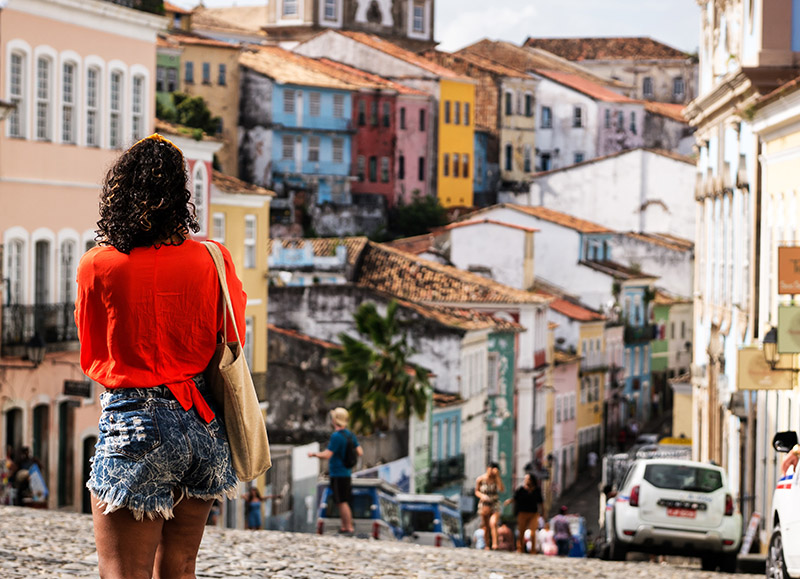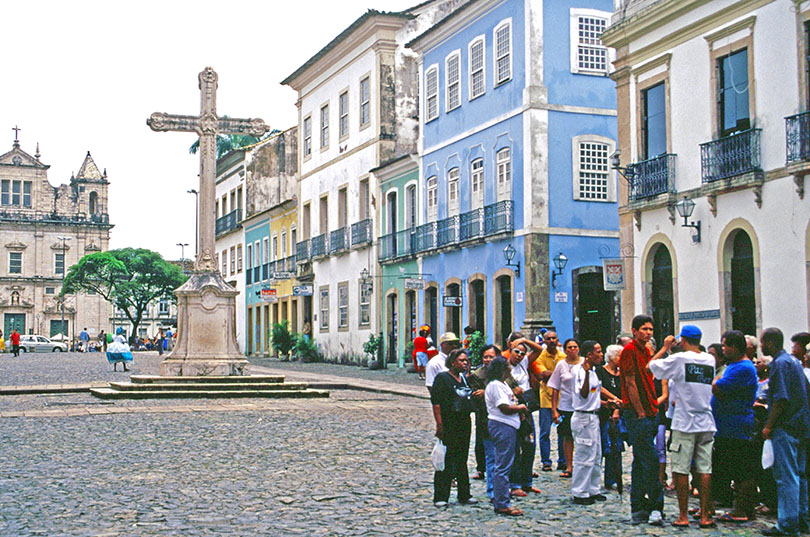
Viewing the historic Pelourinho District; credit Nigel SB Photography
Salvador da Bahia History
The earliest recorded people to have lived here were the Gé Indians thousands of years ago. Archeologists say the Gé were usurped by the Tupinambá Indians, who remained present when the first Europeans arrived. Under the command of the Spanish crown, captain Vicente Yáñez Pinzón landed to the north of present-day Recife, Bahia in January 1500.
A veteran of the trans-Atlantic journey, Pinzón had also been the captain of the Niña when Christopher Columbus made his maiden voyage to America.
Next, to arrive was Pedro Álvares Cabral sailing under the Portuguese crown, who was on his way to India by way of Africa’s Cape of Good Hope. But he made a wide southernly swing westward into the Atlantic Ocean to avoid unfavorable currents before heading east. Unexpectedly, Cabral landed in that which came to be called “Brazil” in April 1500. He anchored at a site that he named “Porto Seguro” which means “Safe Port.” Porto Seguro is a town in present-day Bahia.
Cabral claimed Brazil for Portugal, calling it the Ilha da Vera Cruz (Island of the True Cross). When it was later discovered that he’d actually been standing on a continent, the name was changed to Terra da Vera Cruz (Land of the True Cross).
In November 1501, Amerigo Vespucci landed in an enormous bay he named “Bahia de Todos os Santos” — “Bay of All Saints”). Conveniently, Amerigo gave his own name to the entire continent via the use of a Latinized form of it by mapmaker Martin Walseemüller in 1507. At first, the term “America” only applied to the continent of South America.
Since Spain and Portugal had previously agreed on how they would divide territory west of Africa between themselves, their major concern was the French, who were not a party to the Treaty of Tordesillas agreement. To counter French incursions, the Portuguese divided Brazil up into 14 capitanias between 1534 and 1536, all with straight, horizontal, north, and south borders. Portuguese grantees of these capitanias were responsible for the administration and defense of their lands. Most of them failed.
To single out one of many examples, in 1537 Captain Coutinho’s boat sank on the reefs off Itaparica. After being safely fished out of the water by Tupinambás, they ate Captain Coutinho.

Cross and cobblestone square in Central Salvador da Bahia; (c) Soul Of America
The general failure of the capitanias spurred the Portuguese Crown to set up a governorship of Brazil led by Thomé de Souza in Salvador da Bahia on March 1549. There, he established a capital for Brazil and a palace for himself. The latest incarnation of his palace, now called Palácio Rio Branco, sits in a commanding position overlooking the bay. Portugal’s claim to Brazil was supported by the Catholic Church, under the condition that parties to the Treaty of Tordesillas would convert the Indians to Christianity.
The Church also allowed Indians who did not convert could be enslaved. The city became the seat of the first Catholic bishopric of Brazil in 1552 and is still a center of Brazilian Catholicism.
Though the Dutch gained control of Bahia from 1624-1625, the Portuguese have otherwise dominated Bahia and all of Brazil since de Souza arrived. Salvador remained the Brazilian capital until 1763 when it was succeeded by Rio de Janeiro.
As a base for Brazilian independence, the city was attacked by Portuguese troops in 1812. It was finally liberated to Brazilian nationhood on 2 July 1823.
Pre-slavery, the principal source of wealth was brazilwood, a source of reddish dye. But slavery elevated sugar as the premier cash crop on immense Bahian plantations. Why not enslave Native Indians? The successful Christian conversion of Indians diminished the pool of available slaves.
Another major factor was the epidemics of smallpox, influenza, and measles brought by Europeans. Lastly, Indians knew the land well enough to and would resist attempts to take their freedom.
Given the fortunes amassed from slave labor, Portugal enslaved an estimated 1.3 million African slaves into Bahia before slavery was abolished in Brazil.
Though Bahia was a slave center for sugar cultivation from the 16th through 18th centuries, not all slaves accepted their condition.
On 14 May 1835, four leaders of the Malês uprising were shot dead by firing squad in Campo da Pólvora, Salvador (where the courthouse stands today). Sixteen participants were sentenced to prison. Eight participants were sentenced to perpetual forced labor. Thirty-four participants were deported to Africa. And forty-five participants were sentenced to lashes at the post for 250 to 1,250 times, at a rate of 50 per day until the total was met. Lash wounds often became infected, so punishment was temporarily halted for recuperation before lashings would renew.
Since Brazilian slavery ended in 1888, Salvador has trailed Rio de Janeiro and Sao Paulo as a Brazilian city of commerce, industry, and government. With less status, it gradually slipped into decline.
In the 1990s, a major city project restored the old downtown area called Pelourinho. Today, Pelourinho is a cultural center at the heart of Salvador’s tourist trade. Unfortunately, and similar to the USA, it forced the removal of thousands of working-class residents to the city’s periphery where they have encountered significant economic hardship.
Thus, Pelourinho is an architectural and cultural jewel made lively by tourists, shop owners, and the Bahian state. Perhaps this was the inspiration for Michael Jackson to record most of his They Don’t Really Care About Us video here.
All Salvador Da Bahia History is not gloom. Brazilians contend that Salvador, not Rio, has the best and most authentic Carnival. For that reason, huge numbers of Brazilians, Americans, and Europeans in the know flock to Salvador to celebrate. At the end of the day, Salvador it remains an international cultural and tourist center.
